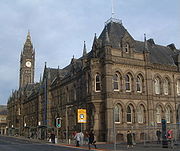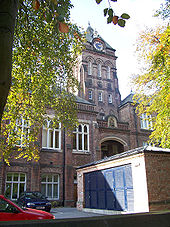
George Gordon Hoskins
Encyclopedia


Royal Institute of British Architects
The Royal Institute of British Architects is a professional body for architects primarily in the United Kingdom, but also internationally.-History:...
(28 October 1837-11 December 1911), was an English architect responsible for the design of several public buildings in the North East of England. His works include many large and important buildings - mansions, banks, hotels, hospitals, libraries, and schools.
"Gee-Gee" Hoskins was the eldest son of Francis Hoskins, an army officer, and his wife Julia Brooks and was born in Birmingham
Birmingham
Birmingham is a city and metropolitan borough in the West Midlands of England. It is the most populous British city outside the capital London, with a population of 1,036,900 , and lies at the heart of the West Midlands conurbation, the second most populous urban area in the United Kingdom with a...
at the end of 1837. He was the grandson of Abraham Hoskins who built the folly of Bladon Castle
Bladon Castle
Bladon Castle is a folly, partly converted into a country house, located some southwest of the village of Newton Solney in South Derbyshire, northeast of Burton-on-Trent and close to the point at which the River Trent forms the boundary with Staffordshire...
at Newton Solney
Newton Solney
Newton Solney is a small village in South Derbyshire, England, located about two miles from the East Staffordshire border, near to Burton upon Trent...
and was brother-in law to the brewer Michael Bass
Michael Thomas Bass, Sr.
Michael Thomas Bass, Sr. was a brewer of Burton on Trent, England, who considerably developed the Bass brewing company.-Biography:...
. Hoskins' godmother was the Duchess of Gordon.
Hoskins studied Architecture in London and Paris and was a pupil of W D Haskoll of Westminster. In 1864 he moved to Darlington
Darlington
Darlington is a market town in the Borough of Darlington, part of the ceremonial county of County Durham, England. It lies on the small River Skerne, a tributary of the River Tees, not far from the main river. It is the main population centre in the borough, with a population of 97,838 as of 2001...
, and his the first domestic commission that year was probably 15 and 16 Westbrook Villas. He became ARIBA
Royal Institute of British Architects
The Royal Institute of British Architects is a professional body for architects primarily in the United Kingdom, but also internationally.-History:...
on 3 June 1867 (proposed by P C Hardwick
Philip Charles Hardwick
-Life:Philip Charles Hardwick was a notable English architect of the 19th century who was once described as "a careful and industrious student of mediaeval art"...
, A Waterhouse
Alfred Waterhouse
Alfred Waterhouse was a British architect, particularly associated with the Victorian Gothic Revival architecture. He is perhaps best known for his design for the Natural History Museum in London, and Manchester Town Hall, although he also built a wide variety of other buildings throughout the...
and J P Pritchett), and was based at Russell Street Buildings from 1867 to 1870. On 2 May 1870, Hoskins became an FRIBA proposed by T Oliver, J P Pritchett and J Ross. He made useful contacts with Quaker families which lead to many commissions including Quaker houses at Woodburn and Elm Ridge, for John Pease in 1867. Extended Quaker connections outside the town led to commissions at the Temperance Hall at Hurworth, (1864), and the Victoria Hall in Sunderland, (1870), which was largely funded by the Backhouse family. He gained the role of architect to the banking house of Backhouse after designing a manager's house added to the Backhouse Bank in 1867. Following this he designed branches in Sunderland (1868), Bishop Auckland (1870), Middlesbrough (1875), Thirsk (1877) and Barnard Castle (1878). His major work was the Middlesbrough
Middlesbrough
Middlesbrough is a large town situated on the south bank of the River Tees in north east England, that sits within the ceremonial county of North Yorkshire...
Town Hall and Municipal Buildings won in open competition in 1882. Alfred Waterhouse
Alfred Waterhouse
Alfred Waterhouse was a British architect, particularly associated with the Victorian Gothic Revival architecture. He is perhaps best known for his design for the Natural History Museum in London, and Manchester Town Hall, although he also built a wide variety of other buildings throughout the...
, R.A. acted as assessor, and the Prince and Princess of Wales
Edward VII of the United Kingdom
Edward VII was King of the United Kingdom and the British Dominions and Emperor of India from 22 January 1901 until his death in 1910...
opened the building in 1889.
In Darlington, major works include the Oueen Elizabeth's Grammar School
Queen Elizabeth Sixth Form College
Queen Elizabeth Sixth Form College, or QE, is a sixth form college on Vane Terrace in Darlington, County Durham, England.-History:It was established in 1970 on the site of the old Queen Elizabeth Grammar School, designed by George Gordon Hoskins...
(1875-6), Bank Top board school (1882), the Pease Public Library (1884), rebuilding of the King's Head Hotel (1890-3), Greenbank Hospital (1885), Poor Law Offices (1896), the Technical College (1896-7), North of England School Furnishing Company, Blackwellgate (1897), and Rise Carr Board School (1902). He was for two years successively President of the Darlington School of Art and President of the Northern Architectural Association from 1886 to 1887. He was for some years a Conservative
Conservative Party (UK)
The Conservative Party, formally the Conservative and Unionist Party, is a centre-right political party in the United Kingdom that adheres to the philosophies of conservatism and British unionism. It is the largest political party in the UK, and is currently the largest single party in the House...
member of the Darlington Town Council and was also a JP
Justice of the Peace
A justice of the peace is a puisne judicial officer elected or appointed by means of a commission to keep the peace. Depending on the jurisdiction, they might dispense summary justice or merely deal with local administrative applications in common law jurisdictions...
. He was injued when the gumaker's shop of Joseph Smythe exploded on 9 October 1894, destroying a substantial part of the town centre. Hoskins retired in 1907, passing the practice to his brother Walter Hoskins. GG Hoskins was almost entirely responsible for Victorian
Victorian era
The Victorian era of British history was the period of Queen Victoria's reign from 20 June 1837 until her death on 22 January 1901. It was a long period of peace, prosperity, refined sensibilities and national self-confidence...
Darlington and his funeral was a solemn public occasion in the town. He was buried in th town's West Cemetery.
Hoskins lived at Darlington at Thornbeck House and later at Harewood Grove. He married twice, first to Isabel Matilda Robinson (1837-1862) the daughter of Joseph Robinson of Southend and they had two children. After Isabel's death he married Ann Hudson only child of William Hudson of Brough, Yorkshire. They had a son and four daughters. Both his sons became architects.
Publications
- "Designs for Chimney Pieces" Darlington 1871
- "The Clerk of Works; a vade mecum for all engaged in the Superintendence of Building Operations" London 1876
- "An Hour with a Sewer Rat: or a few plain hints on House Drainage and Sewer Gases" London 1879

